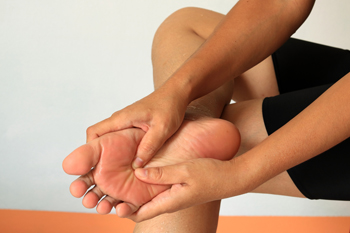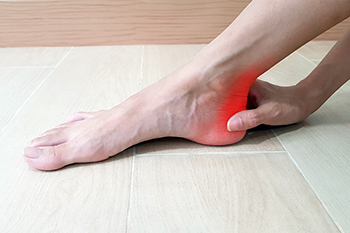Items filtered by date: July 2023
Causes of Pain in the Ball of the Foot

Pain in the ball of the foot, which is the area between the toes and the arch, is termed metatarsalgia. Anything that adds pressure to the ball of the foot, such as dancing, running, yoga, or wearing high heels, can contribute to metatarsalgia. In addition, having high arches, existing foot conditions, excess weight, and aging can also affect the ball of the foot. In some cases, resting the feet and taking pain medication can reduce the effects. But if pain continues, then other factors may need to be considered. For instance, nerve damage, tendonitis, and arthritis may be contributing to this painful condition. Structural factors, such as bunions and hammertoes, may be throwing off the alignment and affecting the ball of the foot. Irritation of the nerves beneath the third and fourth toes may cause Morton’s neuroma, which is sometimes described as having a small pebble in the shoe. This development is more common among women who have been wearing high heels for a prolonged period. If you have increased pain in the ball of the foot, it is suggested that you make an appointment with a podiatrist for an examination and possible treatment options.
Foot Pain
Foot pain can be extremely painful and debilitating. If you have a foot pain, consult with Kenneth Williams, DPM from Texas. Our doctor will assess your condition and provide you with quality foot and ankle treatment.
Causes
Foot pain is a very broad condition that could be caused by one or more ailments. The most common include:
- Bunions
- Hammertoes
- Plantar Fasciitis
- Bone Spurs
- Corns
- Tarsal Tunnel Syndrome
- Ingrown Toenails
- Arthritis (such as Gout, Rheumatoid, and Osteoarthritis)
- Flat Feet
- Injury (from stress fractures, broken toe, foot, ankle, Achilles tendon ruptures, and sprains)
- And more
Diagnosis
To figure out the cause of foot pain, podiatrists utilize several different methods. This can range from simple visual inspections and sensation tests to X-rays and MRI scans. Prior medical history, family medical history, and any recent physical traumatic events will all be taken into consideration for a proper diagnosis.
Treatment
Treatment depends upon the cause of the foot pain. Whether it is resting, staying off the foot, or having surgery; podiatrists have a number of treatment options available for foot pain.
If you have any questions, please feel free to contact our office located in San Antonio and Beeville, TX . We offer the newest diagnostic and treatment technologies for all your foot care needs.
Dealing With Achilles Tendon Pain

Experiencing pain in the back of the leg just above the heel may indicate an injury to the Achilles tendon. The pain may worsen with exercise and subside after resting. There may also be stiffness, swelling, and soreness in this area. A sudden pain in the back of the heel that feels like a kick in the ankle can be a sign of a torn or ruptured Achilles tendon. If this occurs, it is important to seek immediate medical help. A podiatrist will view imaging tests which can diagnose the exact cause of the injury, and determine its severity. A rupture is a full or partial tear in this tendon, which connects the heel to the calf muscles and allows you to walk. Ruptures to the Achilles tendon are more common among men between the ages of 30 and 50. They are also common among women who are 60 years or older. With an Achilles tendon rupture, it may be difficult to walk normally or to stand on tiptoe. This type of injury may be the result of falling, stepping into a hole, sprinting, or sustaining a cut in the back of the heel. Both surgical and non-surgical treatments are common for Achilles tendon injuries. For help in managing an Achilles tendon injury, it is suggested that you make an appointment with a podiatrist.
Achilles tendon injuries need immediate attention to avoid future complications. If you have any concerns, contact Kenneth Williams, DPM of Texas. Our doctor can provide the care you need to keep you pain-free and on your feet.
What Is the Achilles Tendon?
The Achilles tendon is a tendon that connects the lower leg muscles and calf to the heel of the foot. It is the strongest tendon in the human body and is essential for making movement possible. Because this tendon is such an integral part of the body, any injuries to it can create immense difficulties and should immediately be presented to a doctor.
What Are the Symptoms of an Achilles Tendon Injury?
There are various types of injuries that can affect the Achilles tendon. The two most common injuries are Achilles tendinitis and ruptures of the tendon.
Achilles Tendinitis Symptoms
- Inflammation
- Dull to severe pain
- Increased blood flow to the tendon
- Thickening of the tendon
Rupture Symptoms
- Extreme pain and swelling in the foot
- Total immobility
Treatment and Prevention
Achilles tendon injuries are diagnosed by a thorough physical evaluation, which can include an MRI. Treatment involves rest, physical therapy, and in some cases, surgery. However, various preventative measures can be taken to avoid these injuries, such as:
- Thorough stretching of the tendon before and after exercise
- Strengthening exercises like calf raises, squats, leg curls, leg extensions, leg raises, lunges, and leg presses
If you have any questions please feel free to contact our office located in San Antonio and Beeville, TX . We offer the newest diagnostic tools and technology to treat your foot and ankle needs.


